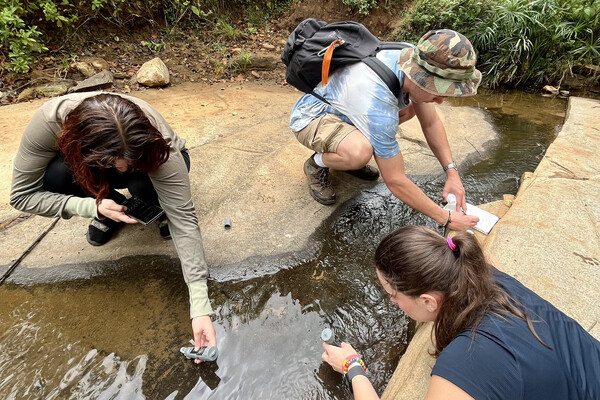
Griffin Pitt, right, works with two other student researchers to test the conductivity, total dissolved solids, salinity, and temperature of water below a sand dam in Kenya.
(Image: Courtesy of Griffin Pitt)

Penn Assistant Professor of Cell and Developmental Biology Aaron Gitler has used yeast cells (pictured) to replicate the way a disease protein responsible for the development of ALS acts in humans.
In humans, the effects of amyotrophic lateral sclerosis (ALS) may take decades to develop. Studying the progression of this disease, then, has proven to be difficult.
But now a Penn researcher has found a promising new way to work around the problem—and he’s turned to a common kitchen product to do so.
In a study that was recently published by Proceedings of the National Academy of Sciences, Assistant Professor of Cell and Developmental Biology Aaron Gitler showed that plain old household yeast could be used to recreate the natural progression of ALS, commonly known as Lou Gehrig’s Disease, in only a matter of hours.
In his lab, Gitler and his co-authors—Brian S. Johnson, also of Penn, J. Michael McCaffery from Johns Hopkins and Susan Lindquist from the Whitehead Institute for Biomedical Research in Massachusetts—successfully used their yeast model to express, or grow, the disease protein called TDP-43, which was recently shown by Penn researcher Virginia Lee to be a likely cause of the disease. Gitler’s breakthrough could represent a significant step forward in the fight to cure ALS, as his yeast method could help researchers better observe how the disease advances—and how it can be stopped.
“We are taking a somewhat unusual approach,” Gitler says. “We are putting the [protein] in yeast cells—the same stuff bakers use to make bread or brewers use to make beer.”
In a way, Gitler’s work builds off that of Lee, director of Penn’s Center for Neurodegenerative Disease Research, who two years ago released a controversial study suggesting it is TDP-43, and not the gene called SOD-1, that is responsible for the development of most cases of ALS. ALS is a neurodegenerative disease that attacks motor neurons and causes degeneration throughout the brain and spinal cord. The disease robs victims of control of their bodies, with symptoms including weakness in the limbs and difficulty swallowing or walking. About 5,600 Americans are diagnosed with ALS each year, with 60 percent of victims being men and more than 90 percent being Caucasian, according to the ALS Association.
Lee’s finding was based on research showing that TDP-43 accumulated abnormally in the brains of patients who have the most common types of ALS. SOD-1 mutations, meanwhile, were seen only in patients with a much more rare version of ALS.
Lee’s finding was controversial and not immediately accepted by others in her field, who continued to advocate for the longstanding SOD-1 model. Recently, however, several other papers have indicated that Lee was right all along, and confirm the importance of TDP-43 in ALS.
“It’s still somewhat contentious,” Gitler says. “But in the last month or so, four studies have indicated [Lee is right]. That’s reassuring to us.”
The “clumping” process of TDP-43 that Lee first discovered can take years or even decades to unfold in humans, but because Gitler and his team can make the process happen in mere hours, other researchers may now be able to more quickly conduct genetic screening studies. These studies may turn up proteins, for instance, that can reverse the effects of mutated TDP-43.
The researchers are also pursuing drug screens using the yeast model. These tests, says Gitler, will allow him to test “thousands” of small molecules and determine which ones can prevent TDP-43 from becoming toxic. Promising leads could then be tested in animals.
Gitler points out that his use of yeast is not entirely revolutionary. While he is the first to put yeast to use in the study of ALS, other researchers have used yeast’s fast-growing properties to study other diseases for decades.
“Almost everything we know about cancer, for instance, we learned based on yeast research,” Gitler says.

Griffin Pitt, right, works with two other student researchers to test the conductivity, total dissolved solids, salinity, and temperature of water below a sand dam in Kenya.
(Image: Courtesy of Griffin Pitt)

Image: Andriy Onufriyenko via Getty Images

nocred

Provost John L. Jackson Jr.
nocred